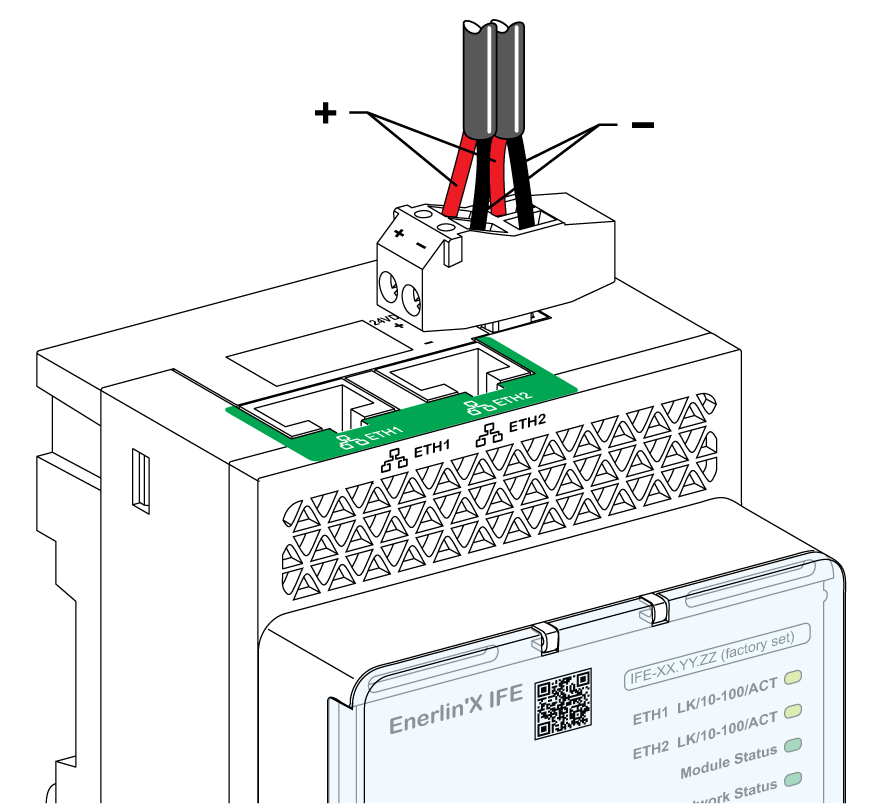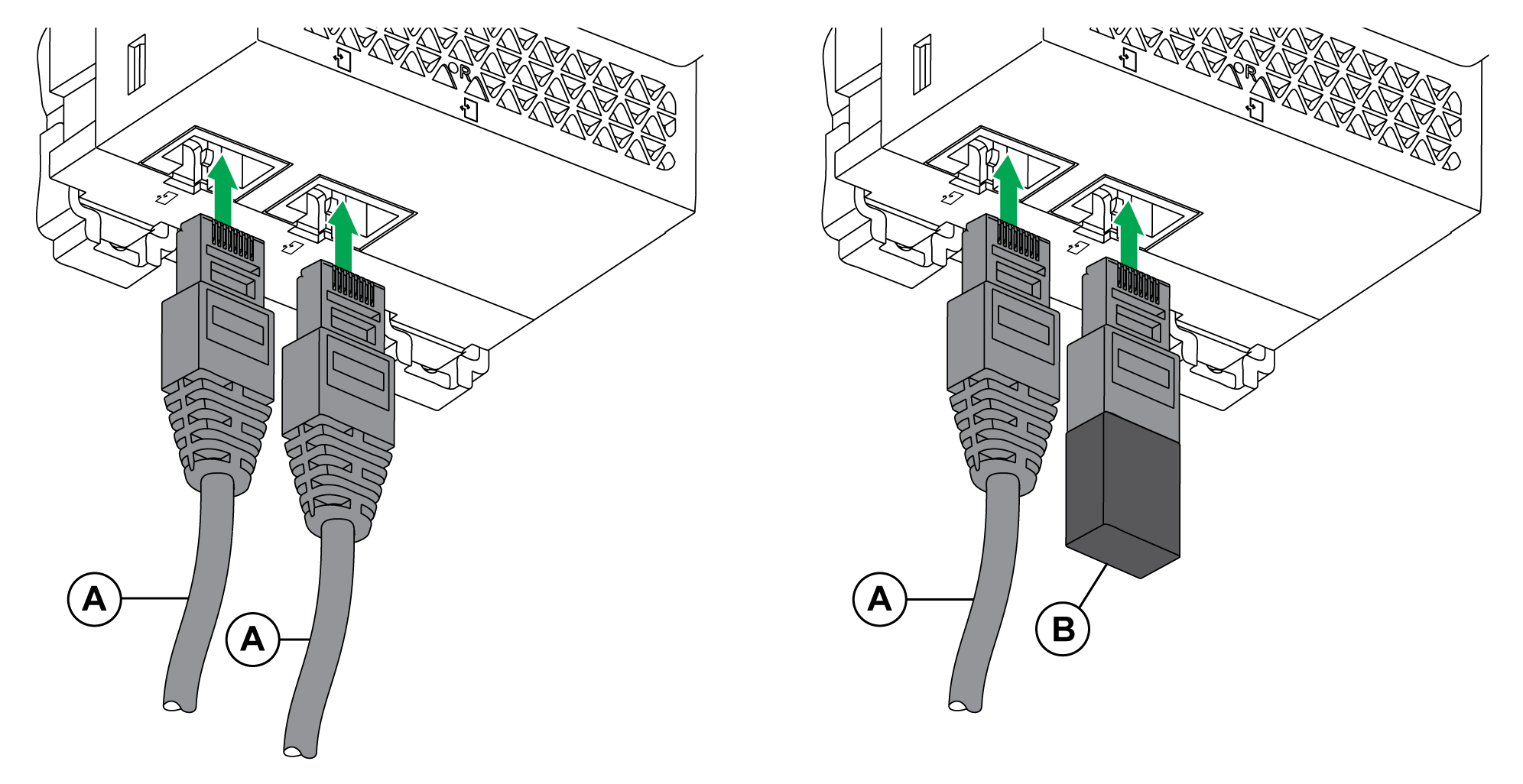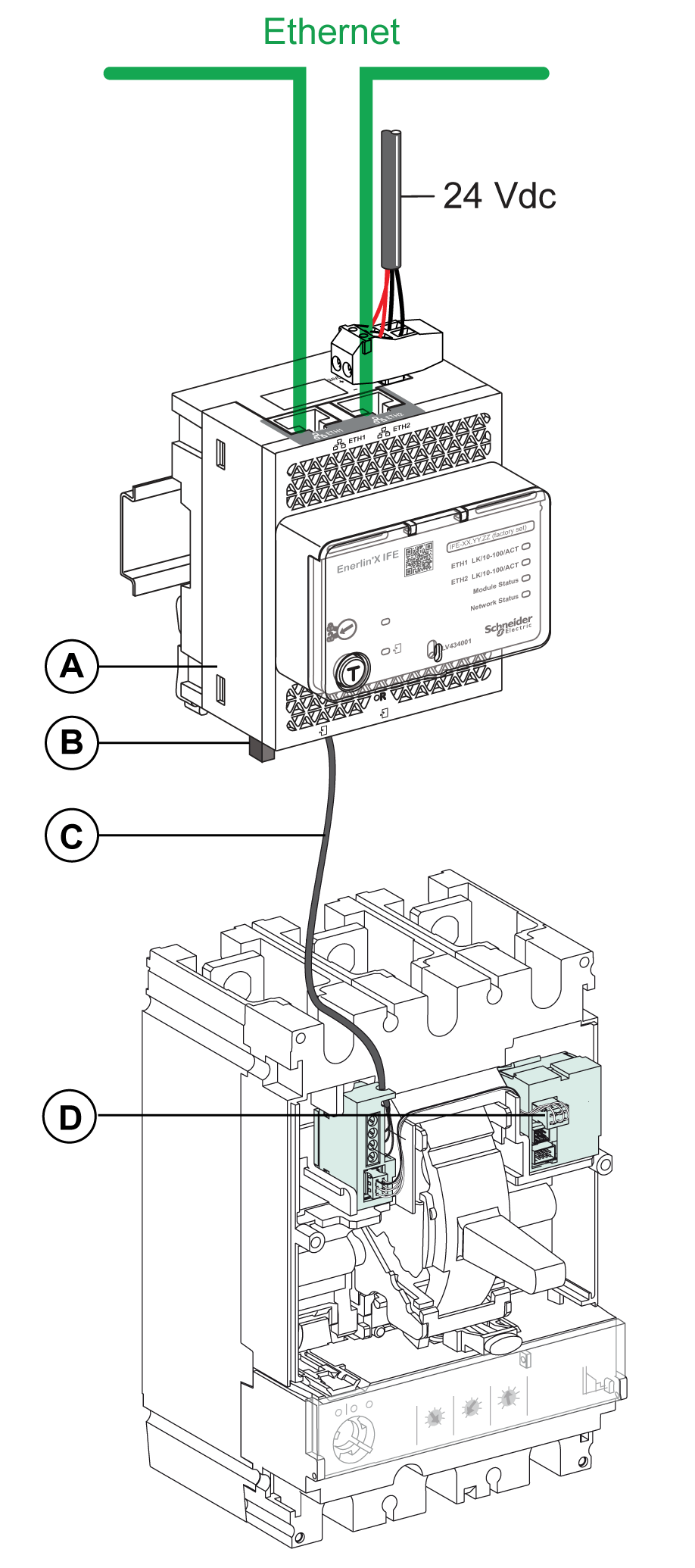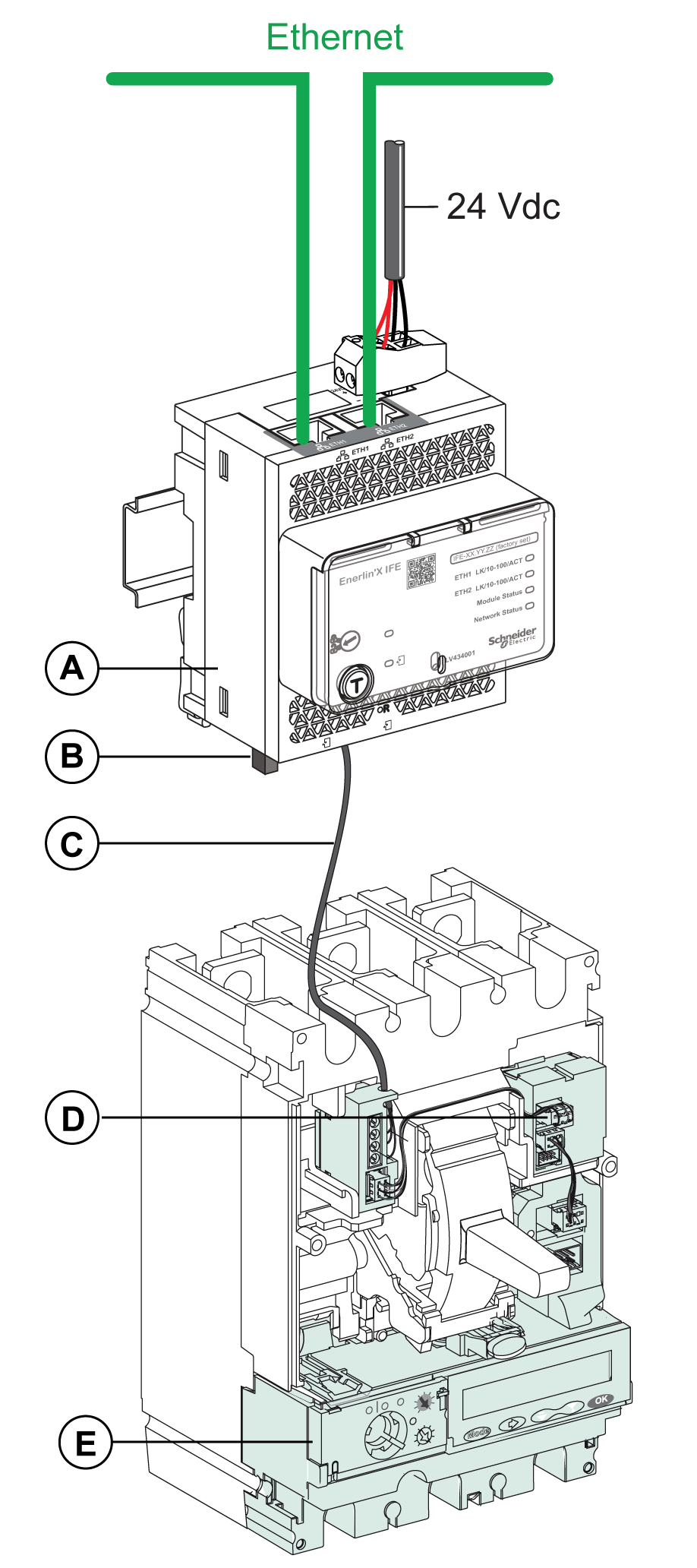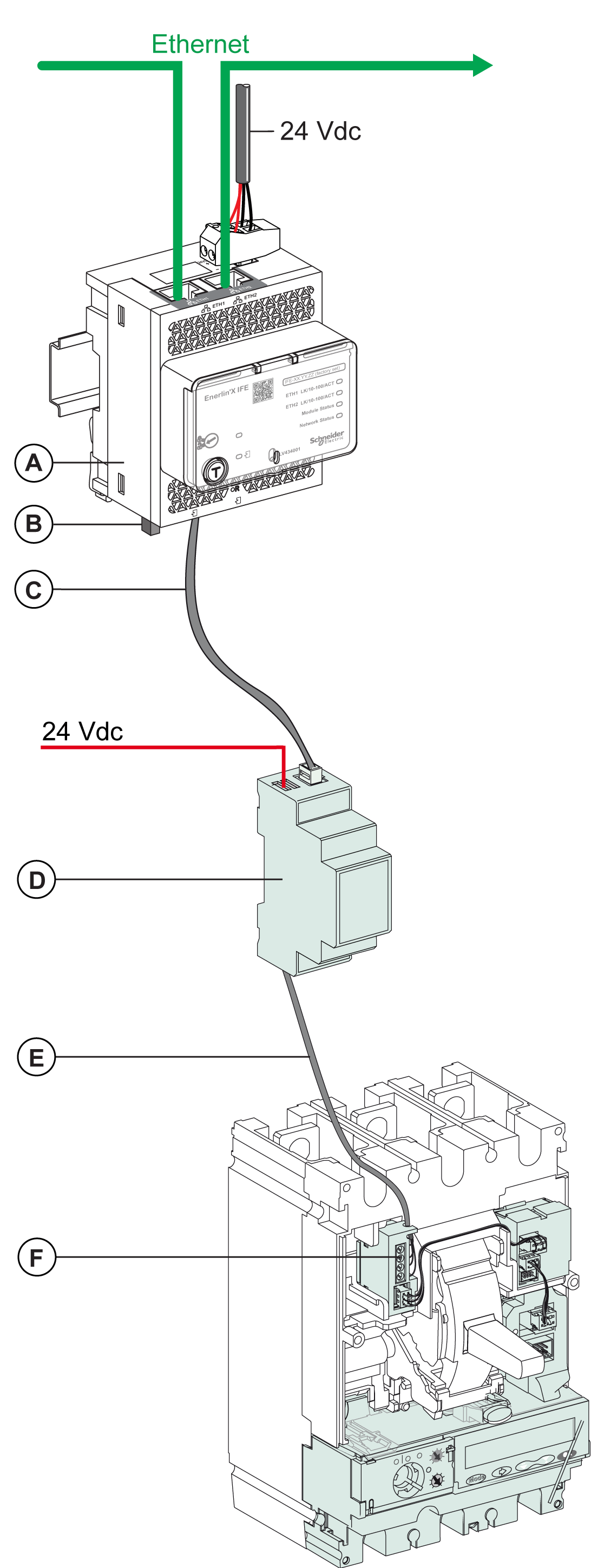IFE Interface
Introduction
Overview
The IFE interface enables an intelligent modular unit (IMU) with a ComPacT, PowerPacT or MasterPacT circuit breaker to be connected to an Ethernet network. Each circuit breaker has its own IFE interface and a corresponding IP address.
Types of IFE Interface
There are two types of the IFE interface:
-
IFE Ethernet interface for one circuit breaker, with part number LV434001
This type of IFE interface is an Ethernet interface for ComPacT, PowerPacT and MasterPacT circuit breakers.
NOTE: The IFE interface with part number LV434001 completely replaces the IFE interface with part number LV434010. The LV434001 comes with the real time clock (RTC) feature and allows ULP connections up to 20 m (65.6 ft) with the MasterPacT MTZ circuit breakers (LV434010 had a theoretical limitation of 5 m (16.4 ft) over the life of the IFE interface). -
IFE Ethernet switchboard server, with part number LV434002
This type of IFE interface is an Ethernet interface for ComPacT, PowerPacT, and MasterPacT circuit breakers and a server for Modbus-SL (serial line) connected devices.
NOTE: The IFE server with part number LV434002 completely replaces the IFE server with part number LV434011. The LV434002 comes with the real time clock (RTC) feature and allows ULP connections up to 20 m (65.6 ft) with the MasterPacT MTZ circuit breakers (LV434011 had a theoretical limitation of 5 m (16.4 ft) over the life of the IFE interface).
IFE Interface Features
The main features of IFE interface are:
-
Dual Ethernet port for simple daisy chain connection
-
Device profile web service for discovery of the IFE interface on the local area network (LAN)
-
ULP compliant for location of the IFE interface in the switchboard
-
Ethernet interface for ComPacT, PowerPacT and MasterPacT circuit breakers
-
Server for Modbus-SL connected devices (only for the IFE server with the part number LV434002)
-
Embedded setup webpages
-
Embedded monitoring webpages
-
Embedded control webpages
-
Built-in email alarm notification for circuit breaker connected to IFE interface.
Hardware Description
Description

|
A |
Ethernet 1 and Ethernet 2 RJ45 communication ports |
|
B |
24 Vdc power supply terminal block |
|
C |
QR code to product information |
|
D |
Ethernet communication LEDs |
|
E |
Module status LED |
|
F |
Network status LED |
|
G |
Sealable transparent cover |
|
H |
Reset button |
|
I |
ULP status LED |
|
J |
Test button (accessible even with closed cover) |
|
K |
Locking pad |
|
L |
Modbus traffic status LED (IFE server only) |
|
M |
Device name label |
|
N |
Two RJ45 ULP ports |
|
O |
Grounding connection |
For information on installation, consult the instruction sheet available on the Schneider Electric website: QGH13473.
Mounting
The IFE interface mounts on a DIN rail. The stacking accessory enables the connection of several IFM interfaces to an IFE server without additional wiring.
24 Vdc Power Supply
The IFE interface must always be supplied with 24 Vdc. The power to the IFM interfaces stacked to an IFE server are supplied by the IFE server and it is not necessary to supply power to them separately.
It is recommended to use an UL listed and recognized limited voltage/limited current or a class 2 power supply with a 24 Vdc, 3 A maximum.
Ethernet Communication LEDs
The Ethernet communication dual color LEDs, indicate the status of the Ethernet ports ETH1 and ETH2.
|
LED Indication |
Status Description |
|---|---|
|
OFF |
No power or no link |
|
Steady yellow |
10 Mbps, link established, and no activity |
|
Blinking yellow |
10 Mbps, ongoing activity |
|
Steady green |
100 Mbps, link established, and no activity |
|
Blinking green |
100 Mbps, ongoing activity |
Module Status LED
The module status dual color LED, indicates the IFE interface status.
|
LED Indication |
Status Description |
Action |
|---|---|---|
|
OFF |
No power |
None |
|
Steady green |
IFE interface operational |
None |
|
Blinking green (250 ms ON, 250 ms OFF) |
Hidden control webpage available |
None |
|
Blinking green (500 ms ON, 500 ms OFF) |
IFE interface firmware corrupted |
Contact your local Schneider Electric service team for support. |
|
Blinking red (500 ms ON, 500 ms OFF) |
IFE interface in degraded mode |
Replace ULP module at the next maintenance operation. |
|
Steady red |
IFE interface out of service |
None |
|
Blinking green/red (1 s green, 1 s red) |
Firmware update in progress |
None |
|
Blinking green/red (250 ms green, 250 ms red) |
Self-test in progress |
None |
Network Status LED
The network status dual color LED, indicates the Ethernet network status.
|
LED Indication |
Status Description |
|---|---|
|
OFF |
No power or no IP address |
|
Steady green |
Valid IP address |
|
Steady red |
Duplicated IP address |
|
Blinking green/red (250 ms green, 250 ms red) |
Self-test in progress |
|
Steady amber |
Error in IP configuration |
Modbus Serial Line Traffic LED
The Modbus serial line traffic yellow LED, indicates that the traffic is being transmitted or received over the Modbus serial line network through the IFE server.
The LED is ON during the transmission and reception of the messages. The LED is OFF otherwise.
Modbus Address
The IFE interface accepts the Modbus address of the IMU to which it is connected.
The Modbus address is 255 and cannot be changed.
Locking Pad
The locking pad on the front panel of the IFE interface enables or disables the ability to send the remote control commands over the Ethernet network to the IFE interface, and to the other modules of the IMU.
-
If the arrow points to the open padlock (factory setting), remote control commands are enabled.
-
If the arrow points to the closed padlock, remote control commands are disabled.
The only remote control command that is enabled even if the arrow points to the closed padlock, is the set absolute time command.
Test Button
The test button has two functions, according to the duration of the button pressed.
|
Time Range |
Function |
|---|---|
|
1–5 s |
Tests the connection between all the ULP modules for 15 s. |
|
10–15 s |
Activates the hidden configuration mode. NOTE: The hidden configuration is not activated
if the button is pressed for more than 15 s.
|
Reset Button
When the reset button is pressed for 1–5 s, it forces the IP acquisition mode to the factory default setting (DHCP).
ULP Status LED
The yellow ULP status LED describes the mode of the ULP module.
|
ULP LED |
Mode |
Action |
|---|---|---|
|
Nominal |
None |
|
|
Conflict |
Remove extra ULP module |
|
|
Degraded |
Replace ULP module at the next maintenance operation |
|
|
Test |
None |
|
|
Non-critical firmware discrepancy |
Use EcoStruxure Power Commission software to check the firmware and hardware compatibility and follow the recommended actions |
|
|
Non-critical hardware discrepancy |
||
|
Configuration discrepancy |
Install missing features |
|
|
Critical firmware discrepancy |
Use EcoStruxure Power Commission software to check the firmware and hardware compatibility and follow the recommended actions |
|
|
Critical hardware discrepancy |
||
|
Stop |
Replace ULP module |
|
|
Power OFF |
Check power supply |
Schematics with PowerPacT H-, J-, and L-Frame Circuit Breakers
General Description
Depending on the configuration of the PowerPacT H-, J-, and L-frame circuit breaker, connect the IFE interface to the circuit breaker using one of the following configurations:
-
Connection of the IFE interface to the MicroLogic trip unit
-
Connection of the IFE interface to the BSCM module
-
Connection of the IFE interface to the BSCM module and to the MicroLogic trip unit
For more information, refer to the ULP System User Guide.
ULP Connection
| NOTICE |
|---|
|
HAZARD OF EQUIPMENT DAMAGE
Failure to follow these instructions can result in equipment damage.
|
All connection configurations require the NSX cord. The insulated NSX cord is mandatory for system voltages greater than 480 Vac.

